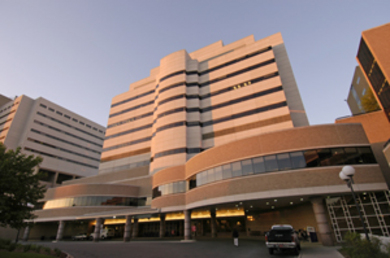U-M Cancer Center reopens after two-day closing due to burst water main
Most of the University of Michigan's Comprehensive Cancer Center is up and running again today after being closed since Tuesday afternoon due to flooding from a burst water main.

University of Michigan Comprehensive Cancer Center
Areas of the University Hospital affected by water damage, including a respiratory therapy area, are still being cleaned and will remain closed today, said U-M Health System spokesperson Michael Steigmeyer. An indoor bridge between the University Hospital and the Cancer Center damaged by the flooding will also remain closed today.
Officials say the first and second floors were the only two damaged by the flooding. The third and fourth floors, though closed Wednesday, did not incur significant damage. The Cancer Center's upper levels, which are used for administrative offices and research laboratories, remained open Tuesday and Wednesday.
A water main located in the mechanical hub of a Medical School building burst at 1:30 p.m. Tuesday and flooded areas of the medical school, University Hospital and Cancer Center. Officials said they are still investigating how long the pipe was broken before the flow of water was stopped by response crews.
For a time, hospital communication systems, including phone service, was affected and patients were transferred from the Cancer Center to Mott. Most non-emergency procedures were canceled. No patients at the Cancer Center, which is mostly an outpatient facility, were injured by the flooding or during the evacuation, UMHS said.
Officials have not determined the cause of the burst pipe yet.
"The investigation of the source of the water line break is under way," Steigmeyer said.
Kellie Woodhouse covers higher education for AnnArbor.com. Reach her at kelliewoodhouse@annarbor.com or 734-623-4602 and follow her on twitter.


Comments
Kai Petainen
Thu, Jan 12, 2012 : 5:18 p.m.
I think there is a silver lining in this event. Although it is just water, one could view this event as an exercise in 'emergency/disaster preparedness'. I think officials will be able to go through this event and analyze what went right (and what went wrong). I'm not referring to what went right/wrong with the actual water break, but from how they quickly reorganized/moved people/kept the operation running. From my perspective, I don't know anything about this situation, but I do know that the public communication between the hospital and this particular event was fantastic. In turn, officials can take that knowledge and share their thoughts to other universities, clean-up crews, hospitals, IT specialists (did it damage any servers/records?), and emergency officials. I think this event, although unfortunate, is a fantastic learning opportunity.